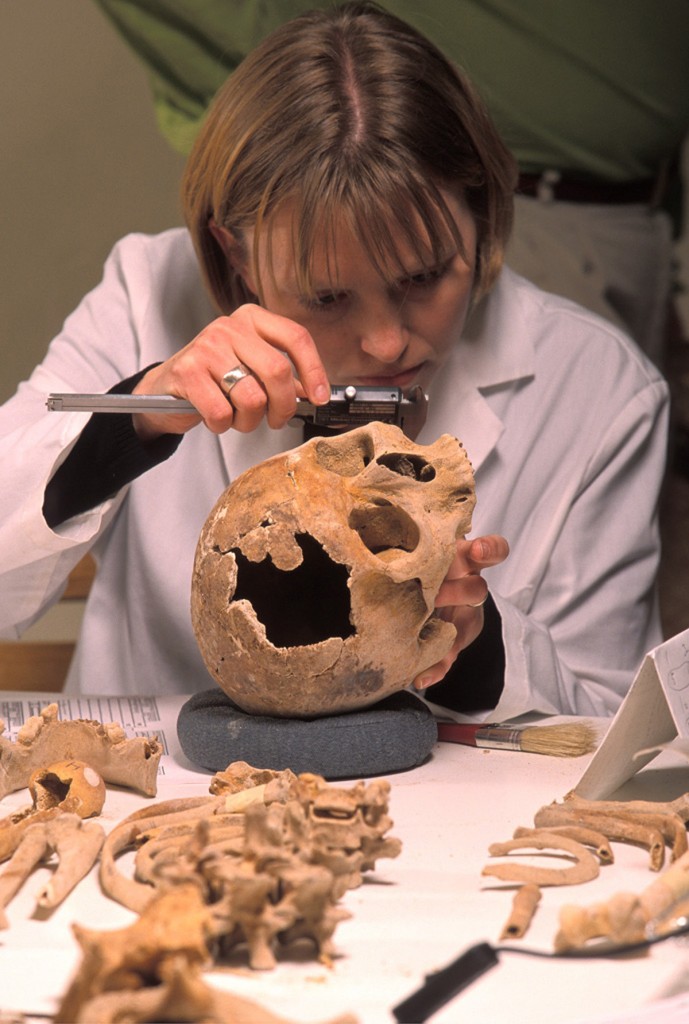What is Forensic Anthropology?
 Forensic anthropology is the discipline that applies the scientific knowledge and analysis of skeletal remains in a legal context (Burns 2013). Forensic anthropology has grown out of physical anthropology into a distinct body of knowledge overlapping other fields such as biology and physical sciences.
Forensic anthropology is the discipline that applies the scientific knowledge and analysis of skeletal remains in a legal context (Burns 2013). Forensic anthropology has grown out of physical anthropology into a distinct body of knowledge overlapping other fields such as biology and physical sciences.
What do forensic anthropologists do?
The main goal of the forensic anthropologists is to aid in the identification of un-fleshed human remains in a legal context. It is the job of the anthropologist to identify whether or not the bones are human. If they are human, to develop a biological profile, which will aid in the identification of the person(s). A biological profile consists of the person’s ancestry, sex, age at the time of death, and stature, as well as any trauma sustained to the skeleton that may aid in the identification of the individual, or give indications of cause of death.
The methods of forensic archaeology are used by forensic anthropologists. A forensic anthropologist uses methods to find and interpret buried or hidden sites of past activity that has a relation to forensic investigations. Anthropologists do extensive evidence searches, recovery of evidence, evidence recording and interpretation of the scene.
Click here to check out the Human Osteology Page
Frequently Asked Questions:
What is the forensic anthropology protocol?
When confronted with a decomposed or skeletalized body forensic anthropologists try to give as much information as possible to law enforcement about the decendents and circumstances surrounding the death event. There are a series of questions or a protocol that forensic anthropologists follow:
1. Are the remains human?
2. Do they represent a single individual or commingled of several?
3. When did the death occur?
4. How old was the individual at time of death?
5. What was the individual’s ancestry?
6. What was the sex of the individual?
7. What was the individual’s stature?
8. Does the skeletal remains have any significant anomalies, signs of disease or injury, and are they unique to the individual’s death?
Questions the forensic anthropologists ask about the death event:
1. When did the death occur?
2. Did the individual die at the place of burial, or was the individual transported after death?
3. Was the grave disturbed, or was the person buried more than once?
4. What was the possible cause of death?
5. What was the possible manner of death?
What is the difference between Cause of Death and Manner of Death?
Cause of death is the way in which someone died (or what caused his or her death). A few common examples are gunshot wounds, stabbing, asphyxiation (strangulation), and being bludgeoned to death (usually referred to as blunt force trauma). The cause of death is not for the anthropologist to determine, but rather a Pathologist’s diagnosis. Manner of death is classified as one of five types: homicide, suicide, accidental, natural or unknown.
Forensic Anthropologist in the Medico-legal community
Forensic anthropologists are key players in the medicolegal community working with coroners, medical investigators and other specialists on criminal cases. People who have died in the last 50 years and are not in the care of a physician are classified as forensic cases that forensic anthropologists will work with. Fifty years is the appropriate period for investing death because this is the time probable that those personally knowledgeable of decedent and any circumstances surround the case might still be alive( Byers 2013).
A medical examiner or officer is called to examine flesh body and a forensic anthropologist is called to examine a skeletonized body. The medical examiner focuses on soft tissues and anthropologist focuses on information taken from hard tissue. However, since decomposition is a continuous process the two specialist often overlap in their study (Burns 2011).
How to become a forensic anthropologist?
To become a forensic anthropologists you first need to specialize in an undergraduate degree in anthropology or biology and then continue on to graduate studies in the similar fields. Most forensic anthropologists are knowledgeable in human biology, anatomy, osteology and archaeology which is extremely important. Many anthropologists in this field learn the basics of medical-legal death investigation through on the job training.
There are no full time forensic anthropologists in Canada, so when skeletal remains are found, typically the police consult a physical anthropologist with a specialty in skeletal biology. Almost all physical anthropologists in Canada teach at universities; others work in museums. Forensic anthropologists in Canada belong to the Canadian Association of Physical Anthropology (http://www.capa-acap.net) and, in many cases, to the Canadian Society of Forensic Sciences (http://www.csfs.ca). In the United States, the employment situation is similar. However, there is also a professional organization to which physical anthropologists working in the forensic anthropology field can belong, the American Board of Forensic Anthropology (http://www.theabfa.org).
More recently forensic anthropologists have been working on more modern situations. Being consultants in the identification of victims in mass disasters. Such as airplane disasters, wars, acts of nature or any other situation in which there are large numbers of individuals who have perished and their remains are dismembered or disfigured.
Many forensic anthropologists are also continuing to work with organizations such as Physicians for Human Rights (http://physiciansforhumanrights.org), United Nations Commission on Human Rights(http://www.ohchr.org) and the UN Refugee Agency (http://www.unhcr.ca) studying and identifying atrocities committed during warfare.
Forensic anthropologists have also become involved in the study of individuals of historical context with no medicolegal significance.